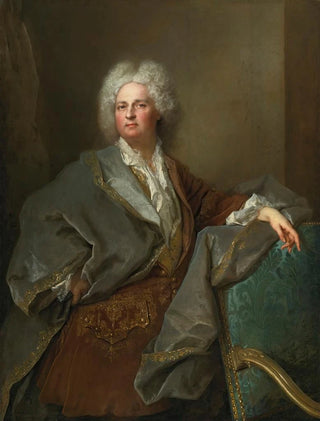Art print | Portrait of Baron de Besenval - Nicolas de Largillière


View from behind

Frame (optional)
Portrait of Baron de Besenval - Nicolas de Largillière – Captivating Introduction
The "Portrait of Baron de Besenval" by Nicolas de Largillière is a work that embodies the elegance and refinement of 18th-century France. This painting, depicting Baron de Besenval, a man of letters and an influential diplomat, is much more than a simple representation. It serves as a visual testimony to the aristocratic life of the era, where every detail, from costume to accessories, tells a story. Gazing upon this piece, one is immediately transported to a world where nobility and culture intertwine, revealing the subtleties of social relations of the time. The art print of this work allows appreciation of its richness and history while making it accessible to a broader audience.
Style and uniqueness of the work
Nicolas de Largillière, master of portraiture, manages to capture the very essence of his subjects with remarkable finesse. In the "Portrait of Baron de Besenval," light plays a crucial role, illuminating the baron’s face in a way that highlights his charisma and personality. The chosen colors, ranging from warm tones to darker shades, create an atmosphere that is both intimate and solemn. The composition is carefully balanced, with the baron placed at the center, surrounded by elements that evoke his status and taste for luxury. Every detail, whether the drape of his coat or the delicacy of his accessories, is rendered with precision that testifies to Largillière’s exceptional talent. This unique style, blending realism and idealization, makes this work a perfect example of portrait painting of its time.
The artist and his influence
Nicolas de Largillière, born in 1656, is one of the most renowned portraitists of his era. Trained at the Flemish school, he developed a style that is uniquely his own, blending European influences while remaining deeply rooted in French culture. His work marked the transition from Baroque to Rococo, and he was able to capture the spirit of his time through his portraits. Largillière not only painted figures of the aristocracy but also contributed to shaping

Matte finish

View from behind

Frame (optional)
Portrait of Baron de Besenval - Nicolas de Largillière – Captivating Introduction
The "Portrait of Baron de Besenval" by Nicolas de Largillière is a work that embodies the elegance and refinement of 18th-century France. This painting, depicting Baron de Besenval, a man of letters and an influential diplomat, is much more than a simple representation. It serves as a visual testimony to the aristocratic life of the era, where every detail, from costume to accessories, tells a story. Gazing upon this piece, one is immediately transported to a world where nobility and culture intertwine, revealing the subtleties of social relations of the time. The art print of this work allows appreciation of its richness and history while making it accessible to a broader audience.
Style and uniqueness of the work
Nicolas de Largillière, master of portraiture, manages to capture the very essence of his subjects with remarkable finesse. In the "Portrait of Baron de Besenval," light plays a crucial role, illuminating the baron’s face in a way that highlights his charisma and personality. The chosen colors, ranging from warm tones to darker shades, create an atmosphere that is both intimate and solemn. The composition is carefully balanced, with the baron placed at the center, surrounded by elements that evoke his status and taste for luxury. Every detail, whether the drape of his coat or the delicacy of his accessories, is rendered with precision that testifies to Largillière’s exceptional talent. This unique style, blending realism and idealization, makes this work a perfect example of portrait painting of its time.
The artist and his influence
Nicolas de Largillière, born in 1656, is one of the most renowned portraitists of his era. Trained at the Flemish school, he developed a style that is uniquely his own, blending European influences while remaining deeply rooted in French culture. His work marked the transition from Baroque to Rococo, and he was able to capture the spirit of his time through his portraits. Largillière not only painted figures of the aristocracy but also contributed to shaping






